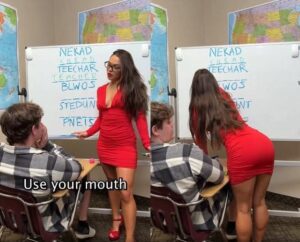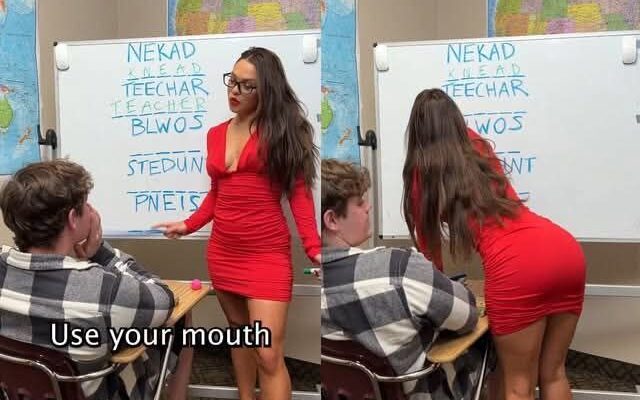
 In early 2023, a seemingly ordinary morning in Monterrey, Mexico, began like countless others. School hallways echoed with laughter and chatter, backpacks shifted against classroom walls, and sunlight streamed warmly through large windows. Students prepared for what they assumed would be a routine history lesson, unaware that within mere hours, their classroom would capture hearts worldwide and become a symbol of education’s enduring potential to inspire.
In early 2023, a seemingly ordinary morning in Monterrey, Mexico, began like countless others. School hallways echoed with laughter and chatter, backpacks shifted against classroom walls, and sunlight streamed warmly through large windows. Students prepared for what they assumed would be a routine history lesson, unaware that within mere hours, their classroom would capture hearts worldwide and become a symbol of education’s enduring potential to inspire.
This story began with a simple two-minute video. No flashy edits. No grand production. Just a teacher, her students, and a moment of pure educational magic. The clip showcased a woman teaching history not as dry, disconnected facts but as vivid stories full of human triumph, struggle, and hope. Her gestures animated battles, revolutions, and discoveries. Her voice, at times soft and empathetic, at others passionate and commanding, guided her students through centuries of human experience.
What followed was astonishing. Within hours of its upload, the video had crossed borders and languages, reaching millions of people eager for something rare in the digital age: genuine, heartfelt inspiration. This story isn’t just about virality. It’s about how one teacher reminded the world of a timeless truth: education, at its core, is an act of love, connection, and shared humanity.
Chapter 1: The Heartbeat of a Classroom
The video opens simply. A teacher stands before her students, no technological gadgets, no dramatic effects, just presence. And yet, what unfolds is transformative. Her movements mirror the flow of history—armies marching, cities rising and falling, revolutions igniting change. Her tone, shifting from excitement to solemn reflection, draws the students in. Even those initially distracted find themselves engaged, fully present in a shared experience that goes beyond rote learning.
When the students posted the clip online, they included a simple caption: “This is what real learning looks like.” That line resonated profoundly. Within hours, shares spread across TikTok, Instagram, YouTube, and X (formerly Twitter). What captivated viewers wasn’t a gimmick but authenticity—the teacher’s sincere dedication and the palpable connection she had with her students. In a world saturated with sensationalized content, this video was a breath of fresh air.
Chapter 2: The Teacher Behind the Moment
Journalists eventually located the woman, who appeared both surprised and humble. She had no idea her lesson was being recorded. In an interview, she said softly, “I am simply doing what I always do—teach with my heart.” She had no plan for fame, no strategy for social media reach. Her goal remained constant: to help students understand not only the events of history but also the human emotions and values embedded within them.
In an age increasingly dominated by algorithms, filters, and artificial intelligence, her sincerity stood out. Millions saw in her something deeply human: someone who believed in the power of passion, empathy, and engagement.
Chapter 3: The Science of Passion in Learning
What made her teaching so magnetic was not mere enthusiasm but emotional depth. Educational research confirms what millions instinctively felt watching the video: when learning engages the heart, comprehension deepens. Studies by the American Psychological Association demonstrate that emotional involvement improves memory retention, focus, and empathy.
This Monterrey educator embodied these principles effortlessly. By acting out historical events, she transformed abstract dates and names into lived experiences. Students were not passive recipients of information; they felt history unfold around them.
Her approach echoes the wisdom of educational pioneers—from Socrates’ dialogues to Maria Montessori’s hands-on learning. True education, as demonstrated in this viral moment, awakens curiosity through connection, story, and engagement.
Chapter 4: From Monterrey to the World
The video’s reach was extraordinary. Comments poured in from every corner of the globe:
-
“If school had been like this, I would never have skipped a day.”
-
“She doesn’t just teach history—she paints it.”
-
“This reminded me why I became an educator.”
Teachers worldwide drew inspiration. In India, a science teacher used everyday materials to demonstrate experiments. In Kenya, a literature instructor performed dramatic readings of local folklore. In Canada, a math teacher transformed algebra into rhythmic rap performances. The common thread: creativity rooted in care and human connection.
Education conferences referenced the Monterrey phenomenon. Discussions emerged around the value of emotional engagement in teaching, how creativity could be fostered in schools, and whether passion could outperform rigid standardized tests. In Mexico, the story became a source of pride. In Europe and the U.S., it rekindled debates about teacher burnout and student motivation. Globally, it served as a reminder: even in underfunded classrooms, one dedicated educator can create lasting impact.
Chapter 5: The Universal Appeal
Why did this single lesson resonate with millions? The answer lies in its representation of authenticity. Social media often rewards sensationalism or controversy. Yet here was a lesson celebrated for its honesty, its emotional resonance, and its reminder that education is about presence, not perfection.
Students struggling with motivation, parents concerned about disengaged classrooms, and teachers feeling underappreciated all saw themselves reflected in this story. It became a beacon, affirming that enthusiasm, care, and connection remain powerful forces in education.
Chapter 6: Lessons Beyond the Classroom
The viral video sparked tangible change. Schools began workshops encouraging storytelling, music, and performance as teaching tools. Universities analyzed the clip as a case study in “emotional pedagogy,” studying how empathy and expression could improve learning outcomes.
Despite global attention, the teacher remained grounded. Her classroom remained modest, her students curious. Asked if fame would change her style, she replied, “The only thing I will do differently is believe even more in the power of passion to transform lives.”
Her humility reinforced the story’s message: extraordinary impact does not require extraordinary ego—only extraordinary heart.
Chapter 7: Influence Across Professions
Her story transcended education. Professionals of all kinds—nurses, chefs, engineers, artists—shared how the teacher inspired them to bring passion and intentionality to their work. A nurse remarked, “She reminded me why I became a caregiver.” A chef noted, “I want to create with as much heart as she teaches history.”
The lesson was universal: whatever your profession, true dedication transforms routine into meaningful purpose.
Chapter 8: The Reality of Modern Teaching
Her story also highlighted systemic challenges. Worldwide, teachers face low pay, heavy workloads, and increasing demands from digital education. Yet despite these obstacles, educators continue to show up with energy, hope, and commitment.
This viral moment became a love letter to those often overlooked, reminding policymakers, communities, and students of the intangible, yet profound, value teachers bring to society. Passion, once invisible, was now recognized as an essential educational asset.
Chapter 9: Authenticity in the Digital Age
In a world where online content fades within hours, the Monterrey teacher’s story endures. Why? Because humanity cannot be replicated by AI or technology. Digital tools can deliver information, but they cannot inspire.
Her example stands as a powerful reminder: education is not mechanical. It is emotional, spiritual, and relational. The best teachers guide, narrate, and ignite curiosity, showing students that learning is not only about knowledge but also about empathy and experience.
Chapter 10: A Symbol of Global Hope
Months after the video circulated, it became a staple in teacher training sessions worldwide. Many called her “La Maestra del Mundo”—The Teacher of the World—but she deflected the attention, insisting that the true heroes were all educators quietly transforming lives daily.
Her fame was unintentional, yet her story became a global emblem of hope, reinforcing that genuine passion and care can create ripple effects far beyond any classroom.
Chapter 11: The Deeper Message
At its heart, this story is about more than education—it’s about human connection. Compassion, engagement, and mentorship are timeless values, now reignited in public consciousness. Viewers reflected on their own experiences with teachers who inspired them, proving that one educator’s passion can bridge generations, cultures, and professions.
The story reminds us that inspiration is universal—it speaks a language beyond borders, age, or circumstance.
Chapter 12: The Enduring Legacy
More than a year after the initial viral video, educators continue to reference her teaching. Academic papers cite her approach as authentic pedagogy. Schools use the clip to inspire and motivate. Former students now mentor the next generation, carrying forward the spark ignited in Monterrey.
Her guiding principle is simple yet profound: teach with love, and the world will respond.
Conclusion: The Spark That Never Fades
The Monterrey teacher’s story is not merely about viral fame. It is a testament to the enduring power of passion, empathy, and presence. She demonstrated that even in ordinary settings, authentic engagement can transform learning, inspire professionals, and touch hearts worldwide.
While years from now, people may forget the precise details of her lessons, they will remember the feelings she inspired: curiosity, hope, and the undeniable truth that the human heart remains the greatest teacher of all.
